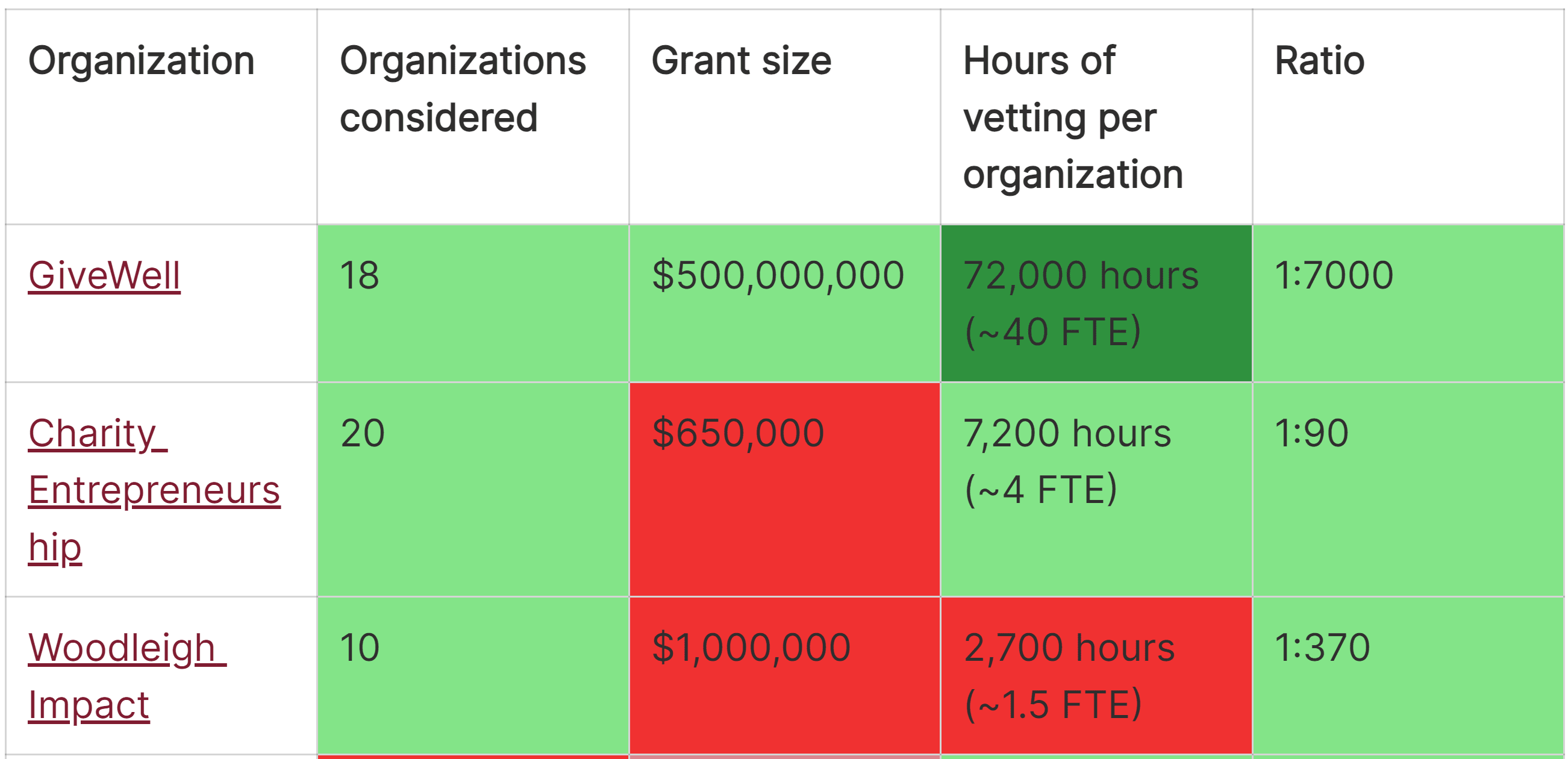On 17 February 2024, the mean length of the main text of the write-ups of Open Philanthropy’s largest grants in each of its 30 focus areas was only 2.50 paragraphs, whereas the mean amount was 14.2 M 2022-$[1]. For 23 of the 30 largest grants, it was just 1 paragraph. The calculations and information about the grants is in this Sheet.
Should the main text of the write-ups of Open Philanthropy’s large grants (e.g. at least 1 M$) be longer than 1 paragraph? I think greater reasoning transparency would be good, so I would like it if Open Philanthropy had longer write-ups.
In terms of other grantmakers aligned with effective altruism[2]:
- Charity Entrepreneurship (CE) produces an in-depth report for each organisation it incubates (see CE’s research).
- Effective Altruism Funds has write-ups of 1 sentence for the vast majority of the grants of its 4 funds.
- Founders Pledge has write-ups of 1 sentence for the vast majority of the grants of its 4 funds.
- Future of Life Institute’s grants have write-ups roughly as long as Open Philanthropy.
- Longview Philanthropy’s grants have write-ups roughly as long as Open Philanthropy.
- Manifund's grants have write-ups (comments) of a few paragraphs.
- Survival and Flourishing Fund has write-ups of a few words for the vast majority of its grants.
I encourage all of the above except for CE to have longer write-ups. I focussed on Open Philanthropy in this post given it accounts for the vast majority of the grants aligned with effective altruism.
Some context:
- Holden Karnofsky posted about how Open Philanthropy was thinking about openness and information sharing in 2016.
- There was a discussion in early 2023 about whether Open Philanthropy should share a ranking of grants it produced then.
- ^
Open Philanthropy has 17 broad focus areas, 9 under global health and wellbeing, 4 under global catastrophic risks (GCRs), and 4 under other areas. However, its grants are associated with 30 areas.
I define main text as that besides headings, and not including paragraphs of the type:
- “Grant investigator: [name]”.
- “This page was reviewed but not written by the grant investigator. [Organisation] staff also reviewed this page prior to publication”.
- “This follows our [dates with links to previous grants to the organisation] support, and falls within our focus area of [area]”.
- “The grant amount was updated in [date(s)]”.
- “See [organisation's] page on this grant for more details”.
- “This grant is part of our Regranting Challenge. See the Regranting Challenge website for more details on this grant”.
- “This is a discretionary grant”.
I count lists of bullets as 1 paragraph.
- ^
The grantmakers are ordered alphabetically.




Thanks for the thoughtful reply, Mathias!
I think this applies to organisations with uncertain funding, but not Open Philanthropy, which is essentially funded by a billionaire quite aligned with their strategy?
Even if the analyses do not contain errors per se, it would be nice to get clarity on morals. I wonder whether Open Philanthropy's prioritisation among human and animal welfare interventions in their global health and wellbeing (GHW) portfolio considers 1 unit of welfare in humans as valuable as 1 unit of welfare in animals. It does not look like so, as I estimate the cost-effectiveness of corporate campaigns for chicken welfare is 680 times Open Philanthropy's GHW bar.
On the one hand, I agree it is important to be mindful of the time it would take to improve decisions. On the other, I think it would be quite worth it for Open Philanthropy to have the main text of the write-ups of its millionaire grants longer than 1 paragraph, and to explain how they prioritise between human and animal interventions. Hundreds of millions of dollars are at stake in these decisions. Open Philanthropy also has great researchers which could (relatively) quickly provide adequate context for their decisions. My sense is that transparency is not among Open Philanthropy's priorities.
Transparency also facilates productive criticism.